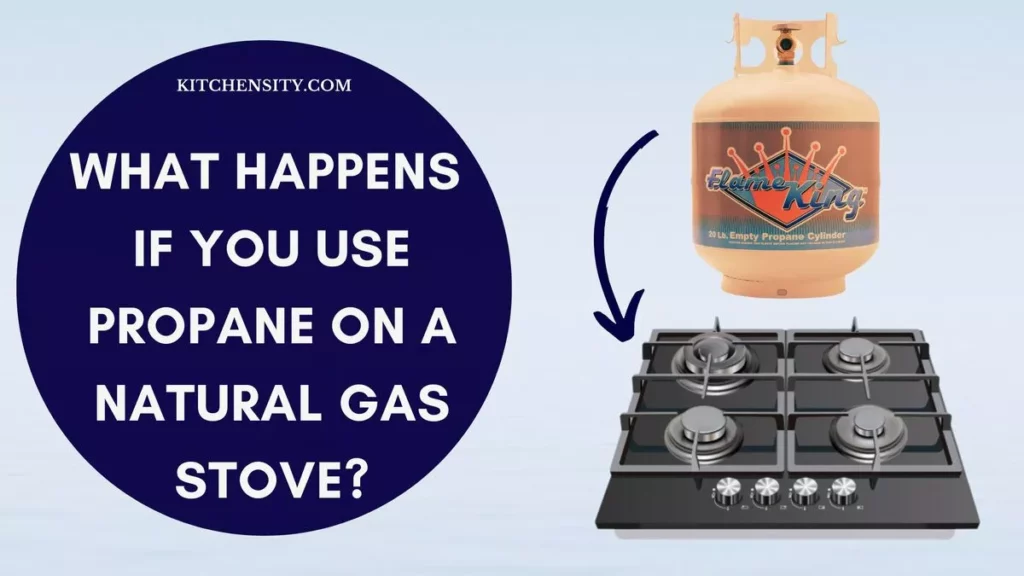Gas stoves are a staple in many kitchens due to their efficiency and precision in cooking. However, over time, the grates on gas stoves can accumulate grease, food residue, and stubborn stains.
Cleaning them thoroughly is essential not only for hygiene but also for maintaining the stove’s performance. In this comprehensive guide, we will walk you through the process of cleaning gas stove grates using a dishwasher, ensuring they sparkle like new without the elbow grease.
![How To Clean Gas Stove Grates In The Dishwasher? [3 Easy Steps] 1 How To Clean Gas Stove Grates In The Dishwasher?](https://www.kitchensity.com/wp-content/uploads/2023/10/How-To-Clean-Gas-Stove-Grates-In-The-Dishwasher-1024x576.webp)
Table of Contents
- 1 Can You Clean The Gas Stove Grates In The Dishwasher?
- 2 Gathering Your Supplies
- 3 How To Clean Gas Stove Grates In Dishwasher? A Step-by-Step Guide
- 4 Can I Put Cast Iron Stove Grates In Dishwasher?
- 5 Are Frigidaire Gas Stove Grates Dishwasher Safe?
- 6 Final Thoughts: How To Clean Gas Stove Grates In The Dishwasher?
- 7 Frequently Asked Questions (FAQs)
Can You Clean The Gas Stove Grates In The Dishwasher?
Yes, you can clean gas stove grates in the dishwasher, but there are a few important steps to follow to ensure they are properly cleaned:
- Check The Manufacturer’s Instructions: Refer to your gas stove’s manual to confirm whether the grates are dishwasher-safe. Some grates are made of materials that may not withstand the dishwasher’s high heat and strong water pressure.
- Preparation: Remove the grates from your gas stove. If they have substantial grease or food residue, it’s a good idea to soak them in warm, soapy water for a few hours to loosen the grime.
- Scrubbing: Use a soft-bristle brush to scrub the grates and remove any loose debris or grease. This initial scrubbing can help the dishwasher clean more effectively.
- Loading The Dishwasher: Place the grates in the dishwasher rack, ensuring they are spaced apart to allow water and detergent to reach all surfaces. It’s recommended not to overcrowd the dishwasher, as this can hinder proper cleaning.
- Dishwasher Detergent: Use a high-quality dishwasher detergent known for its grease-cutting abilities. Add the detergent as per the manufacturer’s instructions.
- Choosing The Right Cycle: Select a heavy-duty or pots and pans cycle on your dishwasher. These cycles provide thorough cleaning and are suitable for cleaning heavily soiled items like gas stove grates.
- Post-Dishwasher Inspection: After the dishwasher cycle is complete, inspect the grates for any remaining residue or stains. If necessary, you can repeat the process or spot-clean any stubborn areas with a brush.
- Air Drying: Allow the grates to air dry completely before placing them back on the gas stove. This step ensures that no moisture is trapped, which can lead to rusting.
Remember, it’s crucial to follow these steps diligently to prevent damage to your gas stove grates and to ensure they are effectively cleaned in the dishwasher. Always consult your stove’s manual for specific cleaning recommendations.
Also Read – How To Clean Gas Stove Grates?
Gathering Your Supplies
Start by collecting all the necessary supplies to streamline the cleaning process:
- Dishwasher-Safe Grates: Ensure your gas stove grates are dishwasher-safe. Refer to the manufacturer’s manual if you need clarification.
- Dishwashing Detergent: Choose a high-quality, grease-cutting dishwashing detergent for effective cleaning.
- Soft Bristle Brush: A soft-bristle brush will help remove any stubborn debris stuck on the grates.
- Vinegar: Vinegar is excellent for breaking down grease and stains, leaving your grates spotless.
Also Read – How To Clean Gas Stove Grates With Ammonia?
How To Clean Gas Stove Grates In Dishwasher? A Step-by-Step Guide
To clean gas stove grates in the dishwasher, start by soaking them in warm, soapy water to loosen grime. Scrub with a brush, load them spaced apart in the dishwasher, use a heavy-duty cycle, and inspect after for any remaining residue.
Learn these steps in detail in this comprehensive guide.
Step 1: Preparing The Gas Stove Grates For Dishwasher
Preparing gas stove grates for the dishwasher is a crucial step that ensures effective cleaning. Here’s a detailed explanation of how to prepare the grates for the dishwasher:
- Removal: Start by carefully removing the grates from your gas stove. Place them on a stable surface covered with newspaper or paper towels to catch any drips or debris.
- Initial Cleaning: If the grates have substantial grease, burnt-on food, or sticky residue, it’s beneficial to give them an initial cleaning. Use a soft-bristle brush, an old toothbrush, or a sponge to remove loose debris. This step helps in loosening surface grime before soaking.
- Soaking: Fill a sink or a large basin with warm water and add a generous amount of dish soap. Place the grates in the soapy water, ensuring they are fully submerged. Let them soak for at least 15-20 minutes, or longer if the grime is particularly stubborn. Soaking helps to soften the grease and makes it easier to remove during the washing process.
- Scrubbing: After soaking, take a soft-bristle brush or sponge and gently scrub the grates. Focus on areas with stubborn stains or residue. The combination of warm soapy water and scrubbing helps to dislodge the grease and food particles from the grates’ surface.
- Rinsing: Once you’ve scrubbed the grates thoroughly, rinse them under running water to remove the soapy residue and any loosened debris. A gentle spray nozzle can help ensure all soap is washed away.
- Drying: Pat the grates dry with a clean cloth or paper towels to remove excess moisture. Proper drying is important before placing them in the dishwasher to avoid excessive water in the dishwasher, which can dilute the detergent and affect cleaning efficiency.
![How To Clean Gas Stove Grates In The Dishwasher? [3 Easy Steps] 2 Soak The Grates In Warm Soapy Water](https://www.kitchensity.com/wp-content/uploads/2023/10/Soak-The-Grates-In-Warm-Soapy-Water.webp)
Step 2: Loading The Dishwasher For Cleaning
After preparing the gas stove grates, the next step is loading them into the dishwasher properly. Here’s how you can do it:
- Rack Placement: Pull out the bottom rack of the dishwasher. Ensure it is clean and free from any debris. The bottom rack is typically designed to hold larger and heavier items, making it suitable for the grates.
- Spacing: Place the grates on the bottom rack, ensuring they are spaced apart from each other. Proper spacing allows water and detergent to reach all surfaces of the grates, ensuring a thorough cleaning.
- Direction: Arrange the grates so that they face down. This position allows water to flow over the dirtiest parts of the grates, maximizing the cleaning process.
- Secure Position: Make sure the grates are securely positioned in the dishwasher rack. Avoid overlapping or crowding them, as this can hinder the cleaning process.
- Detergent Dispenser: Add the recommended amount of high-quality dishwasher detergent to the dishwasher’s detergent dispenser. Using the right detergent is essential for effective grease removal and stain cleaning.
- Selecting The Cycle: Choose a heavy-duty or pots and pans cycle on your dishwasher. These cycles have higher water pressure and longer wash times, making them ideal for cleaning heavily soiled items like gas stove grates.
- Additional Items: If you have other dishwasher-safe items to clean, such as burner caps or smaller kitchen utensils, you can place them in the dishwasher as well. Just make sure they are dishwasher-safe and won’t interfere with the cleaning of the grates.
- Starting The Dishwasher: Close the dishwasher door securely and start the chosen cycle. Ensure the dishwasher is properly connected to a water source and that it functions without any interruptions.
By following these steps, you are ensuring that the gas stove grates are loaded correctly into the dishwasher. Proper loading, along with the right detergent and cycle selection, guarantees an efficient and thorough cleaning process, leaving your grates spotless and ready to be used again.
Step 3: Post-Dishwasher Care
After the dishwasher cycle is complete, it’s essential to give your gas stove grates some post-dishwasher care to ensure they are thoroughly clean and ready to use. Here’s what you need to do:
- Inspection: Carefully inspect the grates to ensure they are clean and free from any remaining residue or stains. Pay close attention to the corners and crevices, as these areas can sometimes retain grime even after the dishwasher cycle.
- Spot Cleaning: If you notice any stubborn stains or leftover residue, use a soft-bristle brush or an old toothbrush to gently scrub those areas. Avoid abrasive materials that can scratch the surface of the grates.
- Rinsing: Rinse the grates under running water to remove any traces of detergent or loosened debris. Thorough rinsing ensures that no soap residue is left on the grates, which can affect the taste and safety of your cooked food.
- Drying: Pat the grates dry with a clean cloth or paper towels to remove excess moisture. Proper drying is crucial to prevent any water spots or rusting. You can also air dry them in a well-ventilated area for a few hours to ensure they are completely dry before use.
- Final Inspection: Give the grates a final visual inspection to make sure they are entirely clean and dry. Any remaining moisture or residue can lead to unpleasant odors or potential rusting over time.
- Reassembling: Once you are confident that the grates are clean and dry, carefully place them back onto your gas stove. Ensure they are properly aligned and securely fitted before relighting the burners.
- Regular Maintenance: To keep your gas stove grates in optimal condition, make a habit of cleaning them regularly. Depending on your usage, a monthly cleaning routine can help prevent buildup and maintain their appearance and functionality.
By following these post-dishwasher care steps, you can be confident that your gas stove grates are not only clean but also well-maintained. Regular cleaning and proper care ensure that your kitchen remains a hygienic and efficient space for all your culinary adventures.
Also Read – Why Gas Stove Grates Are Too High?
Can I Put Cast Iron Stove Grates In Dishwasher?
It is generally not recommended to put cast iron stove grates in the dishwasher. Cast iron is a porous material, and exposing it to the high heat and strong water pressure in the dishwasher can lead to several issues:
- Rusting: Cast iron is susceptible to rusting when exposed to moisture for extended periods. The high humidity inside the dishwasher can promote rust formation on the grates.
- Damage To Seasoning: Cast iron grates are often seasoned with oil to create a natural non-stick surface. Dishwashing detergents can strip away this seasoning, affecting the grates’ non-stick properties and leading to a need for re-seasoning.
- Porosity: Cast iron is porous, meaning it can absorb soap and water. Dishwasher detergent residues can be absorbed into the cast iron, affecting the taste and safety of your food.
Instead, it’s best to clean cast iron stove grates by hand. Here’s how you can do it:
- Cool Down: Allow the grates to cool down completely before handling them.
- Scrubbing: Use a soft-bristle brush or a nylon scrubber to remove any stuck-on debris. For stubborn stains, create a paste of baking soda and water and gently scrub the grates.
- Rinsing: Rinse the grates thoroughly with warm water to remove soap and debris.
- Drying: Pat the grates dry with a clean cloth or paper towel. To prevent rusting, ensure they are completely dry before placing them back on the stove.
- Seasoning: After cleaning, apply a thin layer of vegetable oil or shortening to the grates. Place them in a warm oven for an hour to allow the oil to penetrate and create a protective seasoning layer.
By following these steps, you can effectively clean and maintain your cast iron stove grates without risking damage in the dishwasher.
Also Read – Why Did My Glass Stove Top Crack?
Are Frigidaire Gas Stove Grates Dishwasher Safe?
Yes, Frigidaire gas stove grates are dishwasher safe, as long as they are enamel-coated. Enamel is a vitreous glaze that is applied to metal to protect it from corrosion and rust. It is also non-stick, which makes it easy to clean.
To clean your Frigidaire gas stove grates in the dishwasher, simply place them on the top rack and run a normal cycle. You may want to remove any stubborn food particles or grease with a sponge before placing the grates in the dishwasher.
Once the cycle is complete, remove the grates from the dishwasher and dry them thoroughly with a clean towel. Be sure to inspect the grates for any damage before using them again.
If your Frigidaire gas stove grates are not enamel-coated, you should clean them by hand. To do this, soak the grates in a sink of hot, soapy water for 20-30 minutes. Then, scrub the grates with a sponge or soft brush to remove any grease or grime. Rinse the grates thoroughly with warm water and dry them with a clean towel.
Tips for cleaning Frigidaire gas stove grates:
- Avoid using abrasive scrubbers or harsh chemicals, as these can damage the grates.
- If your grates are heavily soiled, you may need to soak them in soapy water for longer than 30 minutes.
- Be sure to rinse the grates thoroughly with warm water after cleaning to remove any residue.
- Dry the grates completely before using them again.
By following these tips, you can keep your Frigidaire gas stove grates looking and performing their best for years to come.
Also Read – Do Gas Stoves Have Pilot Lights?
Final Thoughts: How To Clean Gas Stove Grates In The Dishwasher?
In the quest for a sparkling, grease-free kitchen, cleaning gas stove grates in the dishwasher emerges as a convenient yet meticulous process. Through a blend of preparation, proper loading, and post-dishwasher care, your grates can regain their lost luster without compromising their integrity.
The careful preparation, involving soaking, gentle scrubbing, and rinsing, ensures that grates enter the dishwasher primed for a thorough cleanse. Loading them correctly, spaced apart and facing down, maximizes water exposure and guarantees an efficient cleaning cycle.
After the dishwasher’s magic, diligent post-dishwasher care, involving inspection, spot cleaning, rinsing, and thorough drying culminates the process, leaving you with grates ready to face culinary challenges anew.
Remember, the specifics of your gas stove grates, including their material and manufacturer’s instructions, are paramount. Always refer to your product manual for tailored guidance, especially concerning dishwasher compatibility.
In the end, maintaining a clean kitchen is not merely a chore; it’s a testament to your commitment to hygiene and culinary excellence. So, embrace the art of cleaning gas stove grates in the dishwasher – a method that blends modern convenience with timeless kitchen wisdom. May your kitchen shine, and your cooking adventures continue, unburdened by the grease of yesterday.
Also Read – How To Fix A Pilot Light On A Gas Stove?
Frequently Asked Questions (FAQs)
-
Can I Clean Cast Iron Grates In The Dishwasher?
No, it is not advisable to clean cast iron grates in the dishwasher, as it can lead to rusting. Hand wash them using mild soap and water.
-
How Often Should I Clean My Gas Stove Grates?
Ideally, clean your gas stove grates once a month to prevent buildup and maintain optimal performance.
-
Can I Use Bleach To Clean The Grates?
Avoid using bleach, as it can damage the grates and leave harmful residues. Stick to vinegar and dishwashing detergent for safe and effective cleaning.
-
My Grates Are Still Greasy After The Dishwasher Cycle. What Should I Do?
If your grates are still greasy, repeat the cleaning process and ensure you are using an appropriate dishwasher detergent.
-
Can I Clean The Burner Caps And Knobs In The Dishwasher?
No, burner caps and knobs should be cleaned separately by hand. Refer to the manufacturer’s instructions for safe cleaning methods.
🔧 Stove Expert | 🔥 Gas Guru | 🏠 DIY Enthusiast | 🎨 Painter Extraordinaire
John Davis is your go-to source for all things stoves, from expert repairs to maintenance tips. With a deep understanding of gas systems, including natural and propane, John ensures your kitchen stays cooking safely. His passion for DIY home and kitchen projects shines through his stunning paint transformations. Trust John to bring warmth and functionality to your home, one stove at a time.






